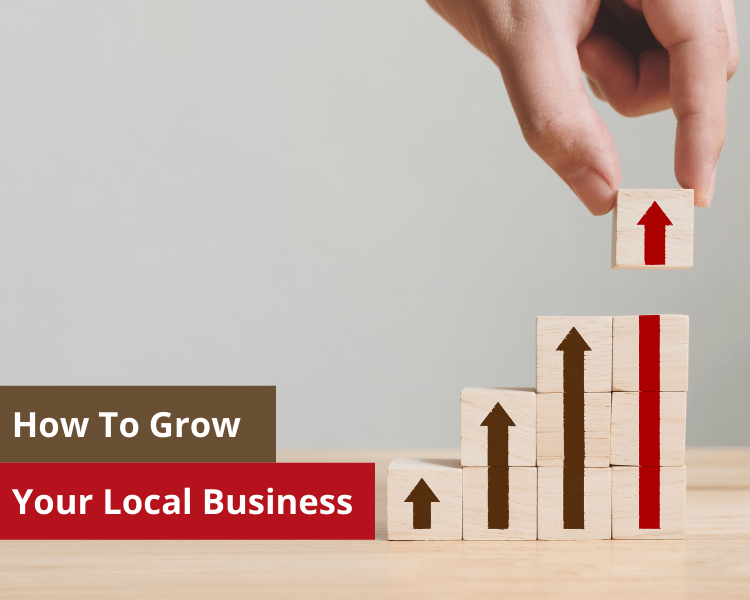
Local SEO Services- Complete Guide to Grow Your Small Business
So, you want to take your local business to the next level? Let us first congratulate you on thinking in the right direction. You already know that growing locally is all about building relationships. In this age of digital transformation, you must be wondering how you can build relationships? Is it? Unlike what many local businesses think, you need to be the “go-to” locals for your target audience.
But that’s the only thing. Local SEO plays an integral part in growing your business locally. If you think creating many social media accounts will serve your purpose, you will end up spending thousands of dollars on paid campaigns without any goal. Undoubtedly, the last two years have been quite challenging for local businesses to grow. The pandemic indeed would have forced you to change a lot of ways you operate. Some of you might have hit the bottom line too.
Did you know that the number of active business owners plummeted by 22% during the pandemic months? However, you don’t have to feel overwhelmed by reading or hearing about the “new normal.” Luckily, if you have access to the right strategies and tools, you can grow your business even in these uncertain times.
How Local SEO Services Fix Small Businesses Unique Challenges?
With so many brands reaching local audiences, the brick-and-mortar businesses already available locally are losing their customers. And with 2020 and 2021 making everything quite scrambled and frustrating, everyone is looking for 2022 as the year of “cautious optimism.” Having said that, there are a lot of unique challenges that a local business faces to grow their business.
Delivering Hybrid Customer Experience:
Did you know more than 90% of customers still prefer offline stores at some point in time to complete their purchases? Even if the transaction happens online, they want to learn about the store through online channels whether they can reach the store through offline channels.
However, many local stores or businesses focus too much on building real-life experiences to forget the hybrid customer experience. Let’s not forget that the internet profoundly impacts customer decisions. SMBs need to understand how to balance online and offline behavior to succeed going forward.
A study found that hybrid shopping is the primary buying method for 27% of all consumers and 36% of Gen Z. However, it might vary according to the types of products you offer. It won’t be wrong to say that hybrid shopping is preferred. In fact, the older generation is also opening their minds towards this buying practice. However, many local businesses are not even using digital means in the right way to grow.
Local SEO Services Help You Get Found Locally:
Many local businesses stick to traditional marketing means like flyers and billboards to reach their customers. However, if you don’t have any local presence online, you will lose visibility to your local community. Without the right business and local SEO, you can’t generate the bread and butter of your lead generation plan. Let’s not forget that more than 45% of searches on Google include local intent. Moreover, more than 97% of customers look for a local business online.
However, many local businesses don’t know the ins and outs of the local SEO, and they end up losing their potential customers. Local SEO is one of the biggest challenges they face. Thus, impacting their chances to be found locally.
Be Chosen By Customers:
There are so many brands available in the market right now. In the U.S. alone, there are more than 31 million small businesses. However, not everyone’s growing at a similar rate. Why? It’s because more than 30% of customers, according to a survey, have trouble finding information about local businesses, especially during the pandemic. Customers can only choose you if you are there. If they can’t find you online, how will they even know you exist? More than 60% of customers currently rely on businesses they can find online.
This kind of engagement requires a lot of personal engagement and attention. And this is where most local businesses fail. They tie themselves to the habits of using traditional means and relying on networking to make themselves visible. This is the process that hurts local businesses a lot.
Local SEO Drive Loyalty To Small Businesses:
Customers purchase something online based on trust. However, more than 80% of consumers lose their trust in a local business when it comes to local businesses because of incorrect or inconsistent contact details.
Clearly, the presence of wrong local citations or its absence makes the businesses lose around 4-5 customers. In fact, younger generations are less likely to trust local businesses in the absence of information online.
Clearly, running a small business isn’t easy. And many things require a lot of time because of their complex nature. This is why you must build a strong online presence for your local business.
But where to begin? Are you looking for steps to grow your business locally? Keep reading, and you will find out some of the actionable steps right here.
Local SEO Services Help Building A Strong Online Presence Of Your Business And Grow Locally.
Shifting consumer behavior and the pandemic propelled the local businesses to lean into digital presence. That was the only way to insulate their business from closures. And who knows about the next breakdown? This is why building an online footprint is of utmost importance. But it isn’t the same as creating one for a national brand. You don’t need the set of digital marketing strategies they are using to impact.
You need a tailored business and local SEO marketing strategy that allows you to compete with local marketers online. The fact remains. More than 95% of consumers go online to research local businesses.
However, as the internet evolves, the definition of a strong online presence changes. This is why you need a data-backed guide. Here is the 6 step Process to grow locally. Let’s begin!
Business Verification On Google Places & Bing Local:
The internet is changing how businesses interact with their customers now. And if you want to grow your local business, you need to give importance to online verification. If you are a small business owner, you might already be attracting new clients or have improved cash flow. However, if you want to give your business an extra leg up, business verification will help you achieve just that.
1. Verify Your Business On Google Places
Clearly, you might already know your Google My Business account if you run a local business. It is one of the most popular ways to provide information about your business, attract customers, and rank higher in local search. Who knows, even if you do it right, you might land your business on the first page.
However, the process isn’t so simple. But still, you can’t miss out on it. After all, 86% of people look at the location using Google Maps. And if your Google My Business (GMB) is unclaimed, it will give your customer a reason to go to your competitor. Businesses enjoyed a 61% increase in calls thanks to their GMB listings if you are still hesitating.
So, how to get started? Here is the process.
Create A Google Account:
This account will give you access to Google Drive, Docs, Photos, Gmail, and more.
Create A Business Profile:
This is the free business listing that appears on Google Maps, local search results, and the Knowledge Panel of Google Search.
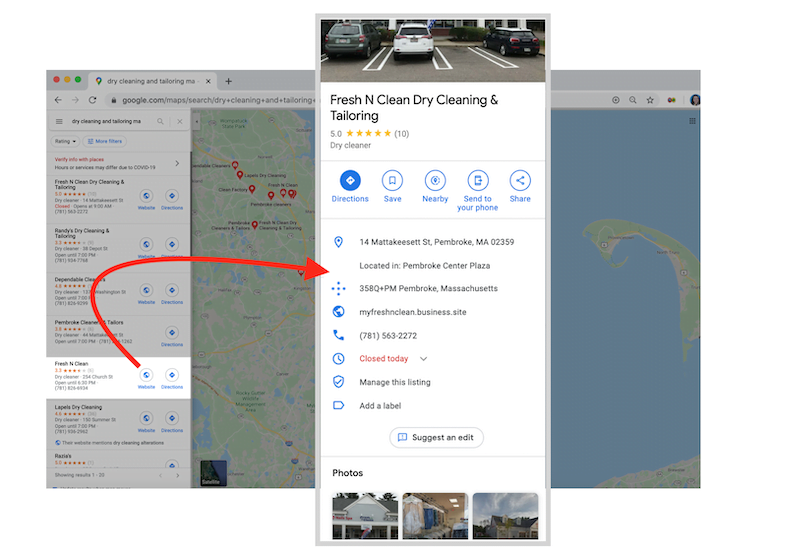
Image Credit: wordstream.com
Create Google My Business Account:
This is the free account that will act as a dashboard of your Business profile.
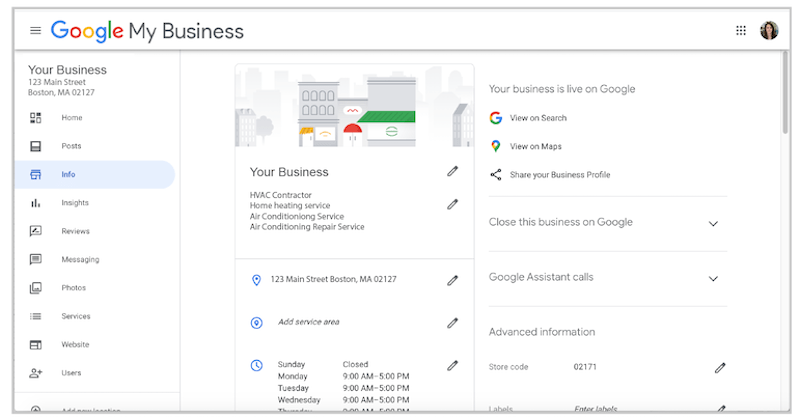
Image Credit: wordstream.com
But how to verify your business? If you want to gain full access to your business profile, you need to use a standard account using a standard Google account. When making your business profile, make sure you provide basic information like Business Name, Address, Website, Phone numbers, Delivery area, and Category. This information is critical for your small business’s local SEO.
Claim Your Business Profile:
You must ask Google to connect your GMB profile with your account, and for this, you need to verify the ownership of your business. For this, you need to locate your business profile on Google Maps and request to claim it. You can either do it by:
- Search google.com and search for your business name or location. If it appears, you can go for the “Own this business” option and select it. From here, you will be taken to the screen that says “Manage this business” by doing so. You can update info and other information. You can click “Manage Now” and follow the prompts to claim your business. Never use your personal profile for this step. Only go for an official ID.
- You can also opt for google.com/maps. Type your business name. Click on your business profile. And click on the “claim this business.” You will find an overlay and click on the “manage now” option.
Verify Ownership:
Whichever method you choose, Google will ask you to provide information to prove that you are the rightful owner. Depending on your account and security requirements, they will send verification codes via text, regular mail, or email. Enter the code in the box, and now you have full ownership.
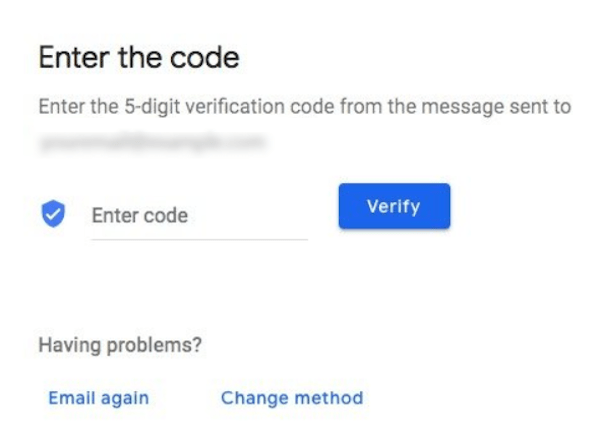
Image Credit: wordstream.com
2. Verify Your Business On Bing Places
GMB isn’t the only place where you should be. After Google, you must opt for a Bing listing. It’s because it will help you become more visible to online customers using the Bing search engine. If you still wonder why? Let us tell you that millions of people search Bind every day. That means you have a chance to get featured in Bing and Bing Map results.
That’s not all! This will boost your Google ranking as well. Remember, Google looks beyond its Google listing when it comes to local citations. Thus, it will help you improve your search rankings as well. But how to get started!
Sign up using a Microsoft email account:
Go to bingplaces.com and sign up using a Microsoft account. If you don’t have an account, you must create one.
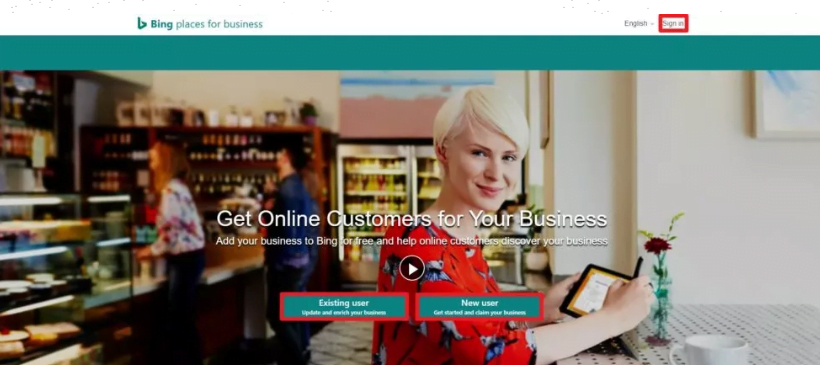
Image Credit: hurrdatmarketing.com
Search for your business:
As you set your business, you must add your business category and the size of your business. You can use your phone number or business name to search on Bing.

Image Credit: hurrdatmarketing.com
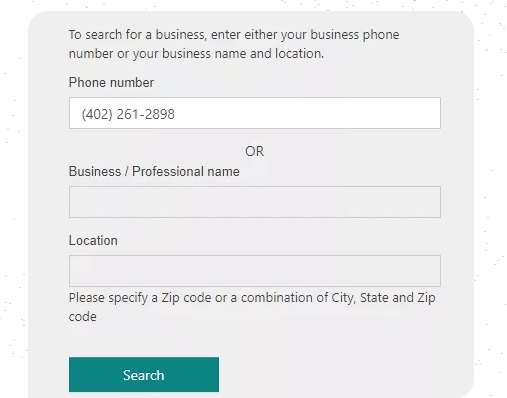
Image credit: hurrdatmarketing.com
When you find it you must tap “Claim and Edit Details.”
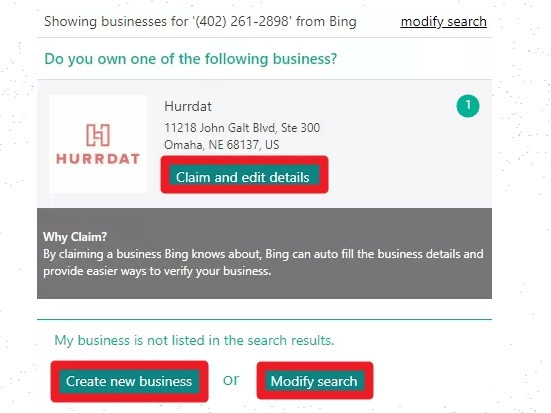
Image Credit: hurrdatmarketing.com
Update your business information:
Add accurate data and use the same information in all places. This will help you save your customer from any frustration because of wrong or different information. You must also click on the map pin. This will help Bing to give information about driving directions. You must add all the relevant information to make the process smoother. You can also add photos relevant to your business.
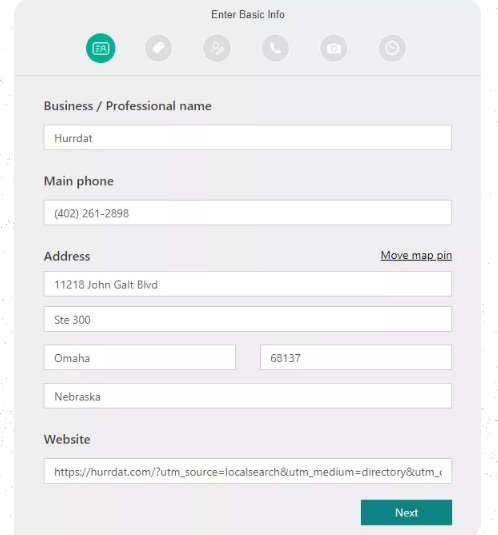
Image Credit: hurrdatmarketing.com
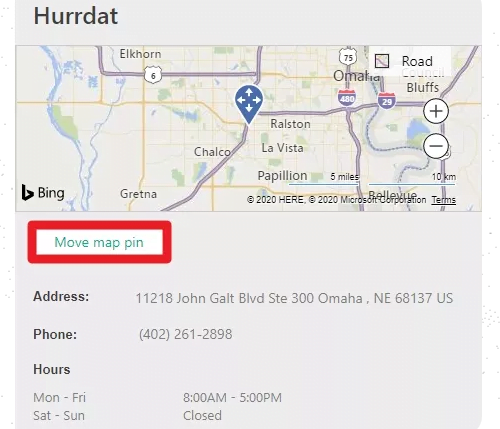
Image Credit: hurrdatmarketing.com
Verify your business:
This is the final step. For verification, you will receive a PIN code either to your email address, via call on your business phone number, through text, or via postcard to your business address. It can also be done using web verification. But you have to answer five questions to find an appropriate verification step.
You can use this method to improve your local SEO strategies and push your customers to reach out to you organically.
Presence On Top Citation Listings:
Local citations are essential for your business since search engine crawlers use them as a ranking metric for local searches. So, if you have a lot of citations, you will have a competitive advantage against the businesses in your niche. The benefits don’t end here. These also act as proof that your business is authentic and reliable. After all, if you mention your business on credible sites, it won’t be fake.
But if you think one or two are enough, you are mistaken. You must have numerous citations to prove that your business is worth it. The more citations, the more are your chances of getting seen. Hence, it will increase your chances of getting a potential customer.
You must be wondering, where can you find these citations, isn’t it? Before that, you must know about the types of local citations.
Types Of Citations:
Structured:
This is ideally the most common type of citation where you see NAP presented on the site with a name, business address, and business calling number. The format is consistent with every listing.
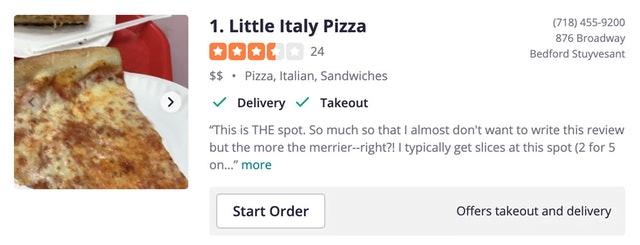
Image Credit: brightlocal.com
Ideally, Yelp and local directories like BBB and industry-specific directories like Tripadvisor are the most common examples of structured citations.
Unstructured:
These are often less common but quite valuable. They don’t follow any format. They usually spread like a piece of information as if your data is provided in a blog or an article by a local newspaper. For instance, you can add them into forum threads or press mentions. It could be something like You can find <business name> on <address>. You can also add things like: Need <service>? Just call <business phone number> to find out more.
However, many business owners still get confused about whether it’s a citation, listing, or directory. To help you understand, look at the image below:

Image Credit: brightlocal.com
Still, wondering whether it’s valuable or not? Honestly, you must never consider citations as a part of your local link-building practice. The value of such citations is much more. A mere mention of your business name will be valuable for your local SEO. Google finds the businesses credible who have a presence and are mentioned in good and credible local citations.
But How To Begin Local Citations For Your Business?
Ideally, Yelp, Yell, LinkedIn, Facebook, and Apple Maps are quite popular in local citations. But you must never put a full stop here. First of all, you must claim a listing. But before that have all the information ready like:
- Business Address
- Telephone number
- Email information (the one with the domain name)
- Ideal Business Category
- Opening Hours
- Social media profile information
- Company logo
- Business photos
This will be handy if you want to target many listing details on several sites. So search online for the list of best citation resources. For instance, you can search terms like:
- {area} business listings
- {niche} directory
- {area} {niche} listings
You must also target blogs relevant to your niche.
- {area} blog
- {area} {niche} blog
However, not all citations are equal. Some citations have better credibility than others. Such sources have higher organic traffic and are quite strong domains. For instance, you can try FourSquare, Hot Frog, Thomson Local, and others.
However, if you want to gain the maximum out of these local citations, you must understand the importance of NAP consistency. It means that you must provide the exact and accurate information about your business on all these sites.
Effective Reviews Management:
Customers are talking about you. And if you grow your citations and social media handles, they will talk even more. So, you need to monitor and manage your reviews and create a process to make the most out of them. Remember, more than 95% of shoppers look for online reviews before purchasing. So, you must know how to leverage user-generated content and reviews as a part of your review management workflow. Remember, more than 70% of customers don’t take any action until they read reviews about the product and the services. This is why you need a dedicated team of experts to help you with online review management.
But how to get started?
1. Create A Review Management Workflow:
The review economy surrounds consumers who are willing to share their experiences. Either exceptional positive or negative experiences trigger most responses. Customers often look for a local business review site to discuss their experiences. This is why proactively asking for reviews can help you avoid the risk of any negative comments. You can take an example of the workflow mentioned below to spread the word.
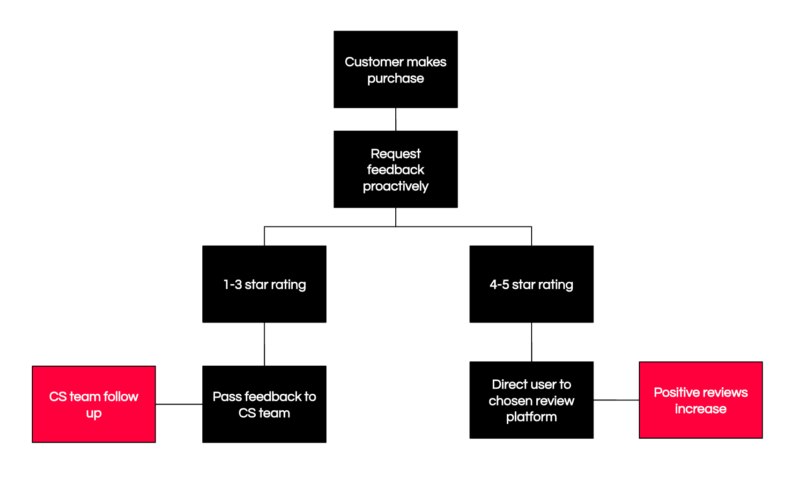
Image Credit: searchengineland.com
The benefit of doing this will help you gain the most visibility with the right kind of reviews. You will also be able to funnel customers towards whichever review platform tends to hold the most weightage for your business. However, make sure you keep gating the negative reviews. Google might suspend your account. What else?
2. Sign Up For Review Platforms:
You must maintain a presence on review platforms in your location and niche. As we mentioned, GMB is the best way to popularize your platform or services. But you must also opt for Yelp.
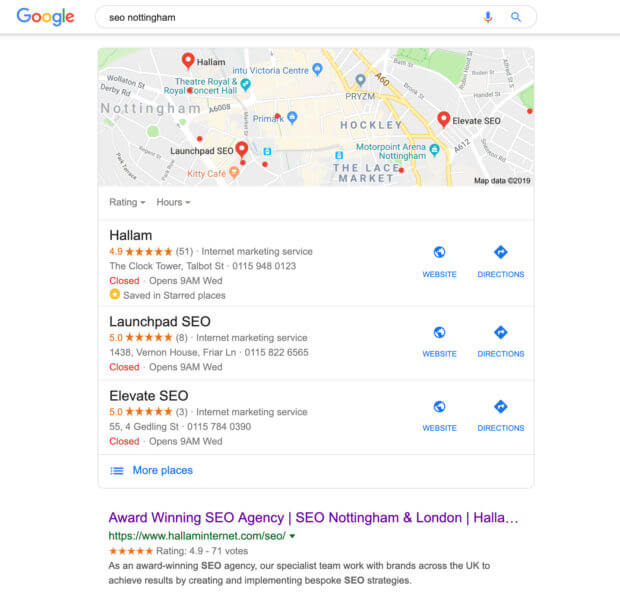
Image Credit: searchengineland.com
Remember, you must not only rely on GMB. You must also have a presence on other review sites since customers will look for you on more than one review platform.
3. Display Reviews On Your Site:
You must not only rely on third-party review platforms. You must use them to engage with your audience on your own platform. So, create a review format so that you can use this for customer testimonials, case studies, service-specific reviews, or ratings.
4. Respond To Negative Feedback:
While you must engage with the customers who left positive comments, never forget that poor reviews can hamper your growth. However, if you respond to them accurately and help your customers navigate their challenges, it will only reflect that you care. But if you want to respond to such comments, this must be your guiding principle: (a) Never be confrontational, (b) address their pain point, (c) be apologetic about it, (d) Make things right, and (e) Respond timely.
Business Optimization For Voice Search:
Google, Alexa, Siri, and Cortana are ruling the markets. You can find customers using these voice search tools a lot now. According to a survey, more than 70% of consumers will be using voice to shop. Moreover, more than 55% of consumers use voice search to find a local business online.
This is why understanding the local voice search ecosystem is important to let the audience find you through these innovative means. This is why you must follow the steps mentioned before. Claim your local business listing on Google, Bing, Apple, and Yelp. Remember that your target audience is searching for local businesses using voice search tools.

Image Credit: localmarketinginstitute.com
Ideally, people look for businesses using discovery, direct, and knowledge-based search queries. For example, What are the best clothing stores near me? Or make a reservation with this restaurant? You can use discovery searches to find new clients and direct searches for real-time connections and engagements.
While knowledge-based searches are relatively difficult to capture, you can use them to find what your customers are looking for online and create content around it. But how to begin?
Here’s how!
1. Optimize For Apple Siri:
You can do it by getting your local business on Apple Maps. You will need an Apple ID and optimize your information on that business listing. They have no reviews or photos of their own. They have connected with Yelp. This is why you optimize your website with this option and get discovered.
2. Optimize For Google Assistant:
If you have the GMB listing, it will help you get the reviews. But at the same time, it will also help you optimize it for voice searches.
3. Optimize For Amazon Alexa:
Alexa gets all the local business data primarily from Yelp and Yext. So, you can use this option to send business listings to Alexa directly.
4. Optimize For Microsoft Cortana:
If you have a Bing business listing, it will help you get discovered using this voice search tool.
Engage On Social Media:
Social media is the place everybody is now. People can miss out on search engines for days. But social media is life for everyone. Statista confirms that the US alone has around 302 million users. You might be crazy busy taking care of other aspects of your business. And imagine Facebook isn’t alone.
You have Instagram, LinkedIn, Twitter, Tik Tok, and many other platforms where your audience is engaging every day. Can you afford to miss out on millions of audience? This is why you must do it right to grow your local business substantially.
This is how you must start engaging on social media:
Connect With Customers On Facebook:
Facebook has over 1.4 billion active users. But a fraction of them live near your business. You can engage with them using Facebook pages. You can promote check-ins at your company. This will give your business free visibility. You can add some targeting tools to your boosted posts using Ads Manager. You can also engage with your audience using Facebook events and consistently post your brand and why customers should connect with you.
Leverage Twitter:
Twitter might not be a typical social media platform. But if you use it in the right way, you can gain a lot of things. It will allow you to interact with your audience. Just make a killer header and a bio that pushes people to follow you. You can also take advantage of Twitter lists. This will allow you to create segmented groups and connect with exciting people in your local community.
Generate Leads Through LinkedIn:
You are highly mistaken if you think LinkedIn is just for B2B brands. Many SMEs and B2C and D2C brands are also making their presence felt on this platform. You can build your authority here and show your audience why you stand out from the rest.
Build Your Business On Instagram:
If you have a solid visual brand, Instagram can help you generate leads and build your local marketing options.
Whatever option you choose, make sure that you follow the steps mentioned below:
1. Encourage User-generated Content On Your Business Profile:
This will allow you to showcase your audience’s positive impact and image. Plus, it will push the audience to engage with your posts.

Image Credit: follows.com
2. Reply On Comments:
This is the best way to improve your engagement. However, many businesses often overlook it. Many companies also post content and forget about it. When you start replying, you can engage them in a conversation, making them feel important.
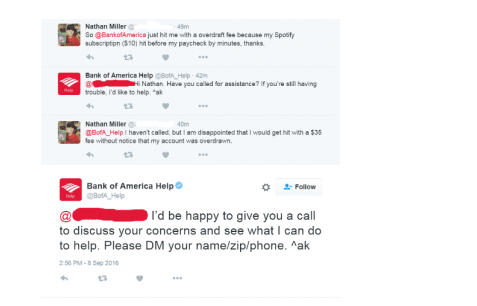
Image Credit: thesocialobserver.com
3. Ask Questions:
You can post different content pieces and drive your customers to tell you what they are looking for. This is why asking questions and polls is fantastic.
4. Maintain Consistency When Posting Content:
If you see low engagement, it’s because people aren’t seeing your content. This is why you must post consistently on social media to derive results.
5. Track Your Results:
If you want to see whether you are creating an impact, you must tie your strategies with goals. Only then will you be able to check whether the campaign was a hit.

Image Credit: blog.hootsuite.com
Final Thoughts:
Growing a local business isn’t about asking your family and friends to recommend your business. However, it’s about standing out. If you are a local business that wishes to stay ahead and be competitive in this overly competitive world, you must collaborate with a local SEO agency that helps you with strategies, implementation, and generating results.
Are You Looking For Local SEO Experts?